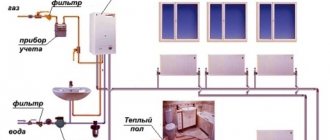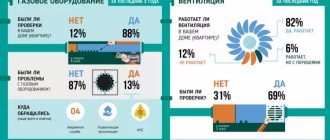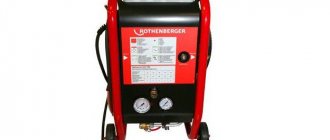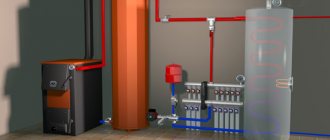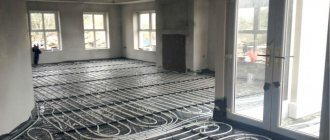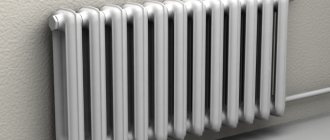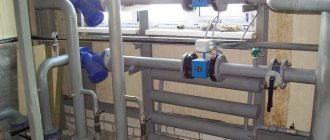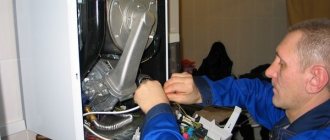Preparing for the heating season
11.1. In preparation for the heating season, in order to ensure reliable heat supply to consumers, it is necessary to carry out a set of measures within the established time frame, the main of which are:
11.2. In preparation for the upcoming heating season, defects in the operation of equipment and deviations from hydraulic and thermal conditions are identified, work plans are drawn up, and the necessary technical documentation and material and technical resources are prepared. Preparation schedules for the upcoming heating period for heat sources, heating networks and heat consumption systems are developed before the end of the current heating period, but no later than May of the current year.11.3. To ensure reliable and safe operation of heat supply systems, timely elimination of accidents and prevention of their development, organizations conduct training on personnel interaction during emergency response, and develop organizational and technical measures (instructions). 11.4. Before the start of the heating period, heat supply organizations develop and approve in local governments schedules for limiting the supply of thermal energy and coolant in the event of taking urgent measures to prevent or eliminate accidents in the heat supply system.11.5. To check readiness for the heating season, when accepting heating points, the following is checked and documented:
11.6. To check the readiness of heating systems and the heat supply system as a whole for operation during the heating period, test fires are carried out before it begins. Test fires are carried out after completion of work to prepare the heat supply system for the autumn-winter period. The start and duration of trial fires are determined by the schedule of the heat supply organization, which should be agreed upon with the local government and brought to the attention of consumers no later than three days before the start of the trial fire.11.7. The heating period begins if, within five days, the average daily outside air temperature is +8 degrees. C and below, and ends if for five days the average daily outside air temperature is +8 degrees. C and above. Turning on and off heat consumption systems is carried out according to a schedule agreed with the energy supply organization.11.8. At the end of the heating season or during shutdown, hot water boilers and auxiliary equipment of the boiler room are mothballed. Conservation methods are selected by a specialized commissioning organization, based on local conditions, based on the recommendations of current guidelines for the conservation of thermal power equipment and are included in the conservation instructions approved by the organization’s technical manager. When putting hot water boilers into operation, as well as before the start of the heating season, heating networks and internal heat consumption systems are pre-flushed. 11.9. Energy supply organizations that have heat sources ensure the creation of regulatory fuel reserves in a timely manner.
__________________________________________
How are preparations going for the heating season?
Responsibility for the complete implementation of the MCH plan rests with the heads of housing and communal services institutions and companies. They are required to organize the work in three stages:
- Preparatory, the results of the last heating season are reviewed, an analysis of failures, breakdowns and emergency situations is performed. During this period, comprehensive health care plans are drawn up, until April 30.
- Completion of restoration and repair work until September 1.
- Checking the readiness of the equipment for the open fire, testing the systems for operability, eliminating identified violations, the period is until September 15, after which the period ends.
Then the cycle repeats. For example, on April 30, 2021, preparations for the 2020-2021 heating season will begin.
The headquarters at local administrations, according to the approved schedule, holds its meetings in the course of implementing plans for preparing for the heating season, during which they review the reports of responsible persons.
After the commissions have discussed the preparation, decisions are made on the results of the implementation of the preparation plan for the region, which are brought to the attention of the population immediately.
Spring inspection of common property
During the spring inspection, the technical condition of housing and communal services equipment, the availability of fuel, the technological reliability of supplying consumers with utilities, and the implementation of technological operating modes of heating networks in the past winter protection period are examined.
The main directions for carrying out a spring inspection:
- Inspection of engineering structures of residential buildings: roofs, windows, doors, walls, condition of insulation systems and in-house utility networks.
- Drawing up an inspection report of objects indicating the necessary types of repairs, material and financial support, persons and dates of completion.
- Based on the inspection report, a health care plan is developed.
- The plan is coordinated with local authorities and approved by the head of the company.
Preparation of activities based on the results of the spring inspection
Based on the results of the spring inspection, organizational measures are drawn up, indicating deadlines for eliminating the detected defects:
- the area where the house is located, the blind area and the basement must ensure high-quality drainage of natural waters;
- structural elements in basements and semi-basements must be in good working order;
- waterproofing of joints and interfaces should not have visible cracks, wet spots, corrosion of reinforcement and peeling of the protective layer of concrete structures;
- the technical condition of the walls is checked by external inspection; there should be no cracks, collapse of plaster or insulation;
- when inspecting windows and doors, check the serviceability of frames, external flashings and completeness of glazing;
- check the roofs to ensure the required temperature and humidity conditions in the attic structure;
- check ventilation systems to ensure complete removal of emissions from gas furnaces and water heaters;
- monitor the state of thermal insulation of intra-house heating and hot water systems.
Drawing up a certificate of readiness of the building for the winter heating period
The passport is made according to a standard sample, and it is issued by the special body that created the commission within 15 days after the document is issued.
The document is issued only when the object is ready for the open plan, or in the case when the deficiencies discovered by the commission were corrected within the prescribed period. The authorized bodies at housing and communal services facilities include territorial authorities.
The time frame for issuing house passports for the heating season is established by the authorized body based on the distinctive features of weather conditions, but no later than September 15 for consumers, and no later than November 1 for heat and power supply companies.
Autumn inspection and drawing up a report
After the restoration work and maintenance of heating networks, a special commission for the preparation of the operational safety documentation, until September 15, carries out an autumn inspection of the work done and the readiness of the buildings for the heating season.
After completing the inspection, the responsible persons adjust the repair plans in accordance with the identified defects at heat supply facilities, which must be eliminated by September 15, after which they proceed to the procedure for issuing reports and obtaining passports.
Connection to existing heating networks is carried out before September 1, and in the period from September 15 to the official start of the heating season, test runs of heat supply installations are carried out. So, as of November 15, 2019, according to the Ministry of Energy of Russia, after an inspection of 941 electric power industry entities on their readiness for the winter season in 2021, 83% received passports; work continues on the remaining facilities.
Cleaning the heating system before the heating season
The first thing to do is flush the inside of the heating system. This stage of preparation for the heating season is very important. Inside, scale and other contaminants accumulate on pipes and batteries. As a result, the wall thickness increases and thermal conductivity decreases. Accordingly, the heating circuit begins to work worse, and energy costs rise.
Professional booster.
There are many flushing options, but the most popular among owners of autonomous heating systems is chemical cleaning. The method does not imply the use of special expensive equipment. All you need is one that you can easily make with your own hands. The principle of flushing is that an acid solution is passed through the circuit for several hours.
Acid corrodes not only scale, but also rust, and can sometimes damage paranite or rubber gaskets. It happens that after chemical cleaning, leaks appear. This is good, since the weak points were identified before the start of the heating season and there is enough time for repairs.
You probably could see how the contours of steel pipes and cast iron batteries are painted over the old layer. Over time, the metal becomes covered with such a layer of paint that the thermal conductivity is significantly reduced.
Replacing the coolant before the heating season
The next stage of preparing the heating system for the heating season is replacing the coolant. If, after flushing the heating system, no leaks or faulty elements were detected, then the circuit can be filled with coolant and it is ready for operation. It is necessary to change the fluid in the heating system, even if cleaning has not been carried out. Experts recommend pouring distilled water or antifreeze into the circuit.
If you have a double-circuit boiler, do not use antifreeze.
The antifreeze has its own service life, after which the liquid begins to break down into its components. The most dangerous component is hydrochloric acid. It turns out that if you do not change the anti-freeze, then acid will circulate along the circuit, which will quickly destroy all elements of the system. The lifespan of the antifreeze liquid is indicated on the packaging.
You can fill the heating system:
- using a pressure test pump;
- through water supply;
- You can even fill the coolant with a bucket.
If the coolant has a minimum iron content and the pH is close to optimal, then the equipment (boiler, pump, radiators) will last much longer. Requirements for the quality of the coolant are indicated in the product passport.
Preparing the boiler room for the heating season
← previous article Boiler house safety Rostekhnadzor monitors compliance with safety standards for boiler houses containing hot water and steam boilers. This organization monitors the design, installation and operation of boiler plants, issues a permit for the builder... next article → Dismantling of a boiler room The need to dismantle a boiler room may arise not only due to an emergency or liquidation of the enterprise that the boiler room served, but also in order to modernize existing equipment, or during re-profiling work...
Author: Alyansteplo
Date: 08/12/2015
Preparing the boiler room for the heating season
usually begins immediately after the end of the previous one. This is a complex process that requires great attention and professionalism.
The preparation of a boiler installation consists of several key stages:
- study of available technical documentation for the boiler room;
- visit of specialists to the location of the facility, its inspection;
- development of a plan for repair and maintenance work;
- compiling a list of necessary spare parts, purchasing them and placing them in the warehouse;
- development of a boiler room modernization project for the heating season;
- creating a report based on the results of the inspection of the boiler room and making a decision on the maintenance of equipment and premises;
- boiler room maintenance (based on the results of the report).
Analysis of technical documentation
in order to prepare the boiler room for the heating season, it can also be carried out remotely: it includes studying the technical passport of the modular boiler room, brands of boilers and related equipment, as well as analysis of the main boiler room diagrams - thermal, electrical, fuel supply diagrams, automation and control equipment, layout diagrams equipment in the boiler room.
After completing the analysis, you need to arrive at the location of the boiler room
to study the correct placement of equipment and its compliance with the provided diagrams. On site, you can get acquainted with those responsible for the boiler room and assess its suitability for the new heating season.
Immediately after previous work, a repair plan
, which is based on the list of equipment and survey results.
Based on regulatory documentation and the operating mode of each individual boiler, a schedule of scheduled preventive maintenance
(PPR) is drawn up, and a list of wear-out devices is created. After this, spare equipment is purchased from among those that wear out quickly. Having a certain number of such parts in stock is mandatory for optimal and reliable operation of the boiler room.
In the heat and power industry, the issue of equipment modernization
, therefore, developing a list of measures to improve existing fixtures is the next step in preparing the boiler room for the heating season. Of course, it is advisable to carry out modernization only when necessary, so before starting this, you need to decide what is wrong with the operation of the equipment at the moment, and how this can be optimized economically.
After this, one of the most important documents when preparing equipment for the heating season is drawn up: a heating supply facility inspection report
, in which the results of the study, difficulties during operation, probable ways to solve problems that have arisen, etc. are entered. Based on the data obtained, a decision is made on the need for maintenance of the boiler installation, which is based, first of all, on the economic side of the issue.
Direct work to prepare the boiler room for the heating season
include the following items:
- checking heat and water meters, as well as electricity meters;
- checking control devices, protective equipment, grounding loops, electrical circuits, drainage systems, boilers for damage and malfunctions;
- repair of lighting equipment, if necessary, replacement of light bulbs;
- cleaning and repair of fans, ventilation motors;
- cleaning of all filters in the boiler room;
- cleaning of heat exchangers;
- cleaning chimneys and related equipment from accumulated soot and other combustion products;
- maintenance of boilers and burners, water treatment equipment;
- inspection, cleaning and emptying of fuel tanks.
The reliability and correct operation of a heating installation largely depends on the correct preparation of the boiler room for the heating season. This moment is most convenient for identifying and troubleshooting problems, so you need to approach the preparation process very seriously.
To calculate the cost of the boiler room, please fill out the questionnaire for the boiler room. The questionnaire can be filled out online or downloaded. For any questions: phone email
Fill out the questionnaire online
Calculate the cost of the boiler room
You may also be interested in
Features of the production of gas boiler houses Gas boiler houses in Russia are leaders in demand and popularity, and this is not surprising: they are economical, reliable and suitable for heating completely different facilities, from social to industrial.
What does technical re-equipment of a boiler house include? Technical re-equipment of boiler houses is a set of measures aimed at partial or complete replacement of equipment. Worn out and outdated system elements are subject to modernization, the decrease in efficiency of which affects the efficiency of the installation. As a rule, not all elements are subject to replacement, but only part of them.
Table of density, calorific value and viscosity of liquid fuel and gas The table lists the following types of fuel: liquid (light, medium, heavy), gas (natural, liquefied gas-phase, liquefied liquid-phase).
What does a boiler installation consist of? A boiler installation is a whole complex of various devices connected into a single system, the task of which is to convert fuel into energy.
Supersaturated steam Supersaturated steam (sometimes “supersaturated”) is obtained from saturated steam by increasing the pressure at a constant temperature. It can be obtained in two ways: by directly increasing the pressure or by cooling the saturated one - the term “supercooled” is used for this.
Beginning of work
The Russian Federation includes many subjects located in a variety of climatic conditions. Depending on the specific region, the heating season 2017-2018 will be launched at different times. In addition, experts take into account seasonal characteristics, since weather conditions even in one region can vary greatly from year to year.
The same applies to preparatory work, since their timing is directly dependent on the launch of heating systems. However, certain time frames are established by law within which all work must fit:
- 10th of March. Before this date, test work on hydraulic tests of heat exchange systems must begin;
- March 12. The start of testing of heating mains and heating stations is scheduled for this date;
- May 25. By this date, all repairs and other preparatory work must be completed;
- October 15. The last day when it is allowed to start heating houses and social infrastructure buildings. In exceptional cases, for individual premises this period may be extended by two weeks.
However, the heating season may be opened earlier than expected if weather conditions require it. The following rule is established by law: if the average daily temperature for 5 days remains at +8 degrees Celsius and below, then heating must be started immediately, regardless of the date. This measure is due not only to the issue of ensuring a comfortable temperature in homes and other premises, but also to material and technical needs. If heat supply systems are not put into operation at this temperature, then they may be damaged in the future under the influence of cold weather, which entails significant financial costs.
However, the deadline for starting the operation of heating mains remains unchanged - October 15, 2021. The heating season will last until spring 2021. The specific date for turning off the heating also depends on weather conditions. Planned work to shut down heating systems will begin in April and may last the entire month.
Beginning of work
The Russian Federation includes many subjects located in a variety of climatic conditions. Depending on the specific region, the heating season 2017-2018 will be launched at different times. In addition, experts take into account seasonal characteristics, since weather conditions even in one region can vary greatly from year to year.
The same applies to preparatory work, since their timing is directly dependent on the launch of heating systems. However, certain time frames are established by law within which all work must fit:
- 10th of March. Before this date, test work on hydraulic tests of heat exchange systems must begin;
- March 12. The start of testing of heating mains and heating stations is scheduled for this date;
- May 25. By this date, all repairs and other preparatory work must be completed;
- October 15. The last day when it is allowed to start heating houses and social infrastructure buildings. In exceptional cases, for individual premises this period may be extended by two weeks.
However, the heating season may be opened earlier than expected if weather conditions require it. The following rule is established by law: if the average daily temperature for 5 days remains at +8 degrees Celsius and below, then heating must be started immediately, regardless of the date. This measure is due not only to the issue of ensuring a comfortable temperature in homes and other premises, but also to material and technical needs. If heat supply systems are not put into operation at this temperature, then they may be damaged in the future under the influence of cold weather, which entails significant financial costs.
However, the deadline for starting the operation of heating mains remains unchanged - October 15, 2021. The heating season will last until spring 2021. The specific date for turning off the heating also depends on weather conditions. Planned work to shut down heating systems will begin in April and may last the entire month.
Preparing your heating system for winter step by step
There is no life without heating. It is very unpleasant to be left without heating in winter or on the eve of frost to realize that the house is warming up in parts or the radiators are “a little warm”. Preparing the heating system for winter will help you avoid the problem, which must be done strictly step by step.
Heating system preparation steps
The first step should be to check the tightness of the heating circuit. To do this, we fill the heating system with water. We fill through the drain valve, it is the lowest in the system. Bottom filling with water allows air to be forced out of the system.
The system is filled completely, and air release is controlled using air vents.
Leave the filled system for 1-2 hours. This time is enough to bypass the entire heating system and check for the absence or presence of leaks in the system
We pay special attention to the connection points of heating devices, pipe connections and all kinds of threaded connections
We pay special attention to the pressure gauge readings. If you don’t see any leaks, but the pressure gauge drops, then we continue to look for leaks
Any leaks found are noted for elimination.
If possible, we fix leaks immediately. If the leak is serious, we fix it after draining the water and recheck the system for leaks.
After eliminating leaks, if any, of course, we move on to the next step of testing - pressure testing. Pressure testing is the same as checking the heating system, but under pressure, 1.5 atm. We complete the pressure testing by testing the heating boiler.
Important! Depending on the type of boiler, starting the boiler also requires some checks. Checking the boiler is done according to the boiler operating instructions
So for a gas boiler you need to carefully check the gas pipeline and the gas inlet fitting.
After starting the heating boiler, we move on to the next step, checking the heating radiators. We go through all the radiators and feel each section of the radiator. If we find that the radiator section is not warming up, then we lower the temperature in the system, poison the air to eliminate air pockets and check the system again. If we find that sections of individual radiators are not heating well, then these radiators need to be marked and washed after draining the water.
When all checks have been verified, all that remains is to flush the entire system under pressure with clean water.
The preparation of the heating system for winter is completed by filling the tested system with the coolant used (water or antifreeze).
Obotoplenii.ru
Other articles in the section: Heating installation
- Heating system pumps: types and methods of installation of heating circulation pumps
- About the heating system: components of the heating system
- Heating installation tools
- About home heating: professionals about installation of heating systems
- 10 answers to the practical use of antifreeze in heating systems
Certificate of readiness of heating systems and heating networks sample
Certificate of readiness of heating systems and heating networks of the consumer for operation during the heating period 2014 - 2015.
Settlement "____" _____________20___ We, the undersigned, the Perm Department of EDMTO represented by (position, full name) carried out the acceptance of the building’s heating networks and heating networks
The test and inspection results are as follows:
1. During the hydraulic test, the pressure was raised to the required gf/cm2 according to the instructions. In this case: a) after 15 minutes. After turning off the press, the needle dropped to ____ gf/cm2. b) the specific point of water per 1 m3 of volume did not exceed __________ t/h, m3.
2. When inspecting the system, the following defects: a) in the insulation of buildings b) insulation c) in instruments d) in taps
3. Condition of hatches on external consumer networks
4. Flushing the network and system
The consumer is obliged to eliminate the defects established by this act of readiness of heating systems and heating networks by
Provided that the above defects are eliminated, the system can be allowed to connect to the heating network of the heating supply organization
The defects have been eliminated, the subscriber’s system is complete and is considered accepted since “______” ________________ 20_____.
Representative of the heat supply organization ________________ Representative of the consumer ________________ “______” _______________20____
Incoming search terms:
- act on the technical readiness of heating networks and energy receiving devices of installations (24)
- flushing of heating networks before the start of the heating season, form of act (1)
- act on preparation for the heating season form (1)
- act on preparation for the heating season (1)
- act on readiness for the heating season sample (1)
- act of readiness for the heating season form (1)
- certificate of readiness of the heating system for the heating season sample (1)
- act of readiness of the heating system and heating networks of the consumer for operation during the heating period 2017-2018 (1)
- act of readiness of the facility for the heating season sample (1)
- certificate of facility readiness for the heating season (1)
A selection of the most important documents upon request Heating season
(regulatory legal acts, forms, articles, expert consultations and much more).
Regulations: Heating season
Decree of the Government of the Russian Federation dated May 6, 2011 N 354 (as amended on June 27, 2017) “On the provision of utility services to owners and users of premises in apartment buildings and residential buildings” (together with the “Rules for the provision of utility services to owners and users of premises in apartment buildings and residential buildings houses") 5. If thermal energy for space heating needs is supplied to in-house engineering systems via centralized engineering support networks, then the contractor begins and ends the heating period within the time limits established by the authorized body. The heating period must begin no later than and end no earlier than the day following the end of the 5-day period, during which, respectively, the average daily outside air temperature is below 8 degrees Celsius or the average daily outside air temperature is above 8 degrees Celsius.
Articles, comments, answers to questions: Heating season
Circumstances of the case: During the heating season, an accident occurred on the heating main. It was possible to turn off the heat supply for no more than three hours. In this regard, the customer entered into a contract to eliminate the consequences of this accident with a single contractor. There was no competitive procurement procedure. The antimonopoly authority recognized the customer’s actions as unlawful.
The conclusion is based on the fact that in an emergency situation related to the supply of heat to the house during the heating season, the employee was obliged to provide access to her apartment for repair work. Her absence from work was due to valid reasons.
The document is available: in the commercial version of ConsultantPlus
Document forms: Heating season
Form: Certificate of verification of readiness for the heating period of municipalities (heat supply and heating network organizations, heat consumers whose heat-consuming installations are connected to the heat supply system) (recommended sample)
The document is available: in the commercial version of ConsultantPlus
Form: Passport of readiness for the heating period of a municipality, heat supply organization, heating network organization, thermal energy consumer, in respect of which the readiness for the heating period was checked (recommended sample) (Order of the Ministry of Energy of Russia dated March 12, 2013 N 103)
The document is available: in the commercial version of ConsultantPlus
The article was written based on materials from the sites: pandia.ru, dogovor-obrazets.ru, domvpavlino.ru.
Monitoring your home's preparation for winter
The readiness of heat supply organizations and consumers for the heating season is checked by local governments. They form a commission, which includes representatives of local governments, heat supply organizations, housing commissions and the Federal Service for Environmental, Technological and Nuclear Supervision.
The commission checks documents on compliance with the requirements for preparing an apartment building for winter, and, if necessary, inspects the facility. Within a day after the inspection, she fills out a report with the results and conclusion. According to Rules No. 103, the commission concludes:
- the house is ready for the heating season;
- the house is ready for the heating season if the problems are corrected in due time;
- the house is not ready for the heating season.
If the house is not ready for winter, the commission draws up a list of comments with deadlines for elimination. If you are ready, local authorities within 15 days issue a certificate of readiness for the heating period. Houses that are not prepared will be issued a passport after correcting the comments and re-checking.
Samples of the inspection report and readiness certificate are presented in the appendices to Rules No. 103.
Preparing the heating system for the winter season
When creating any type of individual heating, first of all, it is necessary to comply with fire safety rules. This is especially true for houses with stove heating. Your actions:
- Check the chimney and stove for damage. If necessary, correct the masonry, replace the grates and cover the cracks with clay mortar.
- Be sure to clean the chimney of accumulated soot.
- Check that the chimney is touching the elements of the roofing system. The wooden structure should not fit tightly to the chimney.
- Whitewash the repaired structure and heat the stove. If not all the cracks are sealed, you will immediately see.
- Move furniture away from the stove at a distance of at least one meter.
- Cover the flooring near the firebox and ash pan with a sheet of iron or lay out tiles.
- Check the operation of the damper on the chimney and the integrity of the hob, if any.
- Move the electrical system wires, sockets and switches located near the stove to another location.
- Set aside a separate dry room for storing firewood and coal. Calculate your fuel supply in advance so that it is enough for the season.
- Protect your family from possible carbon monoxide poisoning by installing a simple gas alarm.
The rules for preparing and conducting the heating season in a private house using electric heating also need to be known and followed:
- First of all, carefully inspect the cables and replace them if necessary. Do not use wires with damaged insulation - this is a direct path to spontaneous combustion.
- Call a professional to service the electric heaters in your home.
- In order not to be left without heat during natural disasters and possible damage to the power line, take care of an alternative method of heating your home. This could be an energy-independent gas boiler, a wood-burning stove or a fireplace.
If you use a gas boiler for your home, you will also need to prepare for the heating season. Your actions:
- Call a specialist from the gas service to conduct a technical inspection of the equipment.
- Check the operation of the ventilation ducts in the room where the equipment is located.
- Check the heating system for water filling. If necessary, add water so that all batteries and pipes heat up evenly.
- Check the operation of shut-off devices on the heating system.
- Paint the pipes running outside and inside the house with paint.
Get started now
- Check all windows. Set plastic structures to winter use mode. Replace worn seals.
- Entrance doors also need to be insulated. Metal structures do not retain heat in the house if there is no insulation.
- Apply foam sheets to plastered exterior walls and apply a new layer of plaster.
- The attic space is insulated in a variety of ways. The simplest is to smear the base of the attic with a mixture of clay and straw. If the premises are non-residential, lay mineral wool. For the attic space, use penoizol. There are many ways. Choose the best one for yourself.
- Install foil screens behind the radiators, which will help keep the house warm.
Now your home is prepared for winter, and your energy costs will be significantly reduced. You can expect not only comfort and warmth in cold weather, but also savings on your family budget if, after reading the article, you follow all our recommendations.
Russia is one of the most difficult climatic countries. Many regions of the country experience long, frosty winters every year.
That is why, since Soviet times, special attention has been paid to preparatory work. Preparations for the 2017-2018 heating season at heat supply facilities began in the spring of this year
Its effectiveness will determine when and to what extent Russian cities will receive heat in the fall.
It is difficult to overestimate the role of preparing energy supply facilities for winter, given that most homes, schools, hospitals and buildings of other social bodies in the country are heated from a centralized heating system. The same applies to industrial enterprises. To control the process of preparation for the heating season, a fuel and energy department was formed. It is he who establishes the program of preparatory measures on which the 2017-2018 heating season in Moscow and the regions of the country depends.
The larger the subject (city, settlement), the more large-scale work is necessary to prepare it for the autumn-winter period. This is determined by the total number of houses and buildings.
The existing program for preparing settlements for the heating season includes a clearly defined sequence of activities that executive authorities are required to carry out.
The main points of this program are:
- Formation of commissions within the relevant executive state bodies to prepare for the heating season. The main task of such commissions is to monitor the timing and scope of all preparatory activities;
- Formation of a schedule for upcoming work, including procedures for the control start-up of heating systems. Such launches make it possible to identify all existing problems in heat supply systems and identify emergency areas;
- Based on the results of test runs, a general estimate is formed, which includes the costs of all upcoming work.
In other words, preparation for the 2017-2018 heating season consists of checking existing heat supply systems and mains in order to identify emergency areas. Carrying out timely repair work and replacing outdated equipment guarantees a stable supply of heat in the autumn-winter period to all houses and social infrastructure buildings.
Work carried out in preparation for the heating season
All actions to restore heating networks must be linked to a plan for repairing the thermal power forces of heat sources. Persons responsible in accordance with the previously mentioned order must draw up appropriate acts and provide data on the volume of repairs made and the results of inspections carried out.
Checking boiler room equipment
In preparation for the period of heating work, it is necessary to carry out the required measures, which include: repair of boiler heating surfaces, replacement of defective parts of pipes, boiler fittings, air heaters and other installations; repairs to restore fans and pumps; repair and restoration work of chemical water treatment facilities, fuel supply and electrical power equipment; as well as preparing furnaces for heating work and checking heat measuring instruments.
Upon completion of all restoration work, thermal circuits of boiler plants are assembled, where equipment is hydrotested with a pressure of 1.25 of the operating pressure of the steam in the boiler.
Repair work
Based on the results of spring inspections, the following types of repairs should be carried out:
- replacement of pipe parts that are in poor condition;
- repair of various pumps, valves, air vents and flaps;
- restoration of thermal insulation and coating that prevents corrosion;
- repair or replacement of valve control mechanisms and starting devices, as well as instruments that carry out control and measurement work;
- cleaning tanks and mud traps;
- setting up security automation.
After the necessary measures have been taken, the thermal circuit is collected and subsequently tested.
How should devices be checked?
There are certain rules according to which any source and receiver of heat must be equipped with commercial metering devices, and boiler rooms and consumer heating equipment must be equipped with elements of a security system.
In order for all devices to work smoothly and reliably during the autumn-winter period, a thorough check should be carried out, and if necessary, repair of the following devices: adjustment of heat loss and temperature; maintaining pressure in heat supply devices; automatic operation of drainage pumps; as well as devices:
- to protect thermal systems from excess pressure or temperature in the supply network or pressure drop;
- to automatically turn on the spare pump and protect the battery tank from overcrowding;
- by pressure in the network pipeline.
Starting pad and mode cards
Flushing and testing of heating networks with hydraulics is followed by commissioning work on thermal power plants for both companies and consumers. After their implementation, operating schedules for this equipment must be established.
The most important data taken into account in the described cards:
- Estimated volumes of coolant for operational sections of the heating network.
- Operating parameters for pressure in network pipelines: forward and return lines.
- Working temperature graph of network water, taking into account air temperature.
- Waste of thermal fluid from consumers.
- Calculation of heating network temperature expansion.
- Analysis of operating modes of the heating network.
- Calculation of the dimensions of limit washers and nozzles of elevator units for the consumer.
Document on readiness for the heating season
Based on the completion of the necessary repair activities included in the plan, deadlines are set for checking the quality and completeness of the scope of all actions, namely how they correspond to the plan.
To assess how prepared consumers are for the heating period, a special commission checks:
- the completeness of the scope of implementation of all plan activities;
- quality of insulation of objects;
- technical condition of pipes and fittings;
- the presence of washing, pressure testing of devices, regime maps and the availability of commissioning tests;
- operability of devices that take into account electricity;
- functioning of security automation;
- availability of supporting necessary passports.
If complete readiness for the start of heating for the autumn-winter period is revealed, then the preparation of an act that complies with all the rules, signed by members of the special commission, begins. This document may be supported by any important notes on troubleshooting, by eliminating which the passport can soon be received by consumers.
We minimize heat loss before the heating season
You can check your house for heat loss using a thermal imager - this is a device that shows an image in the infrared spectrum. Ideally, the check should be done in winter, and heat loss should be eliminated before the heating season begins.
Photo of a house in the infrared spectrum.
Ideally, on the screen of a thermal imager, the house should be blue - this means that it is cold outside, and therefore heat does not leave the room. All places where heat escapes will be marked in red or yellow. The brighter and more saturated the color, the higher the heat loss. The main places for heat leakage are windows and doors. Therefore, replacing or at least sealing windows and doors is done first.
After all the cracks have been eliminated, the windows are replaced and you can proceed to the thermal insulation of the enclosing structures:
- walls;
- ceiling;
- foundation.
When the heating season ends, the insulation continues to work. Only now it does not let heat from the street into the room, so in the summer it is cooler in such a house. Energy efficient homes are very popular today.
Start preparing your home for the heating season
Heat supply organizations and management companies begin preparations for the heating season immediately after its completion. They wash and pressurize the nets. Conducting tests. Check and, if necessary, change shut-off valves, pressure gauges, pipes and metering devices.
The networks need to be washed and pressure tested to clean them of salts and rust. Without this, a lot of resources are spent on heating, but there is little benefit. Hydraulic tests test networks for strength and detect leaks. The management company and owners eliminate them in the summer.
A complete list of requirements is contained in the Order on preparation for the heating season of the Ministry of Energy of the Russian Federation No. 103 dated March 12, 2013. It specifies the requirements for heat supply organizations and consumers.
Why you need to prepare for the heating season
Reliable performance of housing and communal services facilities, timely and complete preparation for the new heating season is carried out to ensure a stable energy supply to consumers at subzero outside temperatures. Providing the required technological modes for heating buildings is a priority issue for public utilities in the regions of the Russian Federation.
If everything is ready, no problem
Preparing housing and communal services facilities for winter protection is carried out to reduce the impact of temperature and other atmospheric factors on the structural stability of utility facilities, prevent emergency wear and tear and prevent malfunctions of equipment in life support systems.
The preparation of housing and communal services facilities for the heating season must guarantee:
- regulatory technological operation of housing and communal services facilities;
- implementation of the generally established sanitary and hygienic regime for permissible temperatures and humidity in the premises;
- extreme reliability and high efficiency of operation of thermal facilities;
- rational consumption of materials and fuel.
Heating quality
The main criterion for heating quality is the air temperature in the apartment. It depends on the air temperature outside and the water temperature in the heating networks. According to the Decree on preparation for the heating season No. 354, the temperature must be above 18 C°.
To save resources and maintain a comfortable temperature in the apartment, heat supply organizations regulate the water temperature in the networks. If you don’t do this, your house will be cold in cold weather and hot in warm weather.
The main networks of a heating supply organization lose heat due to slagged pipes, leaks, worn thermal insulation and outdated regulators. At the same time, the water temperature and pressure drop, and the heating fee is calculated according to the amount of resource sent. The situation is similar with intra-house networks. A common house heat energy meter helps identify losses and reduce heating bills.
Certificate of readiness for the heating season
After completing all repair work according to the OZM plan, the head of the organization sets a time to check the completeness of the implementation of the action plan. You can download it here.
To assess the preparedness of consumers for the heating season, the commission checks:
- completeness of implementation of the health care plan;
- Carrying out washing and pressure testing of thermal devices;
- availability of commissioning tests and operating charts of equipment;
- level of insulation of buildings;
- technical condition of pipes and shut-off and control valves;
- serviceability of heat and electricity metering devices and their verification;
- serviceability of automatic protection;
- availability of thermal equipment passports, diagrams and production instructions;
- the presence of seals on limit washers and elevator units.
When the consumers' heating facilities are fully prepared for the autumn-winter period, an act of the established form is prepared, which is signed by all members of the commission. Comments may be attached to the act, and deadlines for their corrections may be established. After notifying the commission that the deficiencies have been eliminated, the consumer can receive certificates of the facility’s readiness for the winter period.
